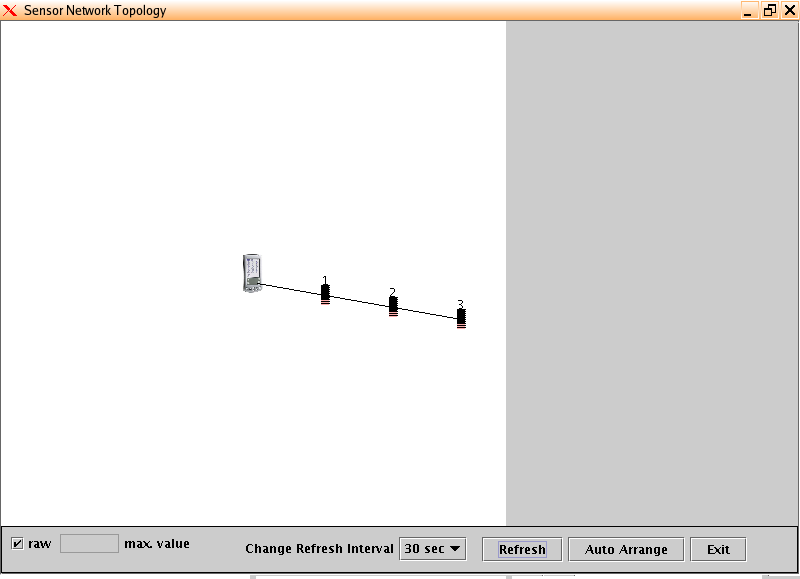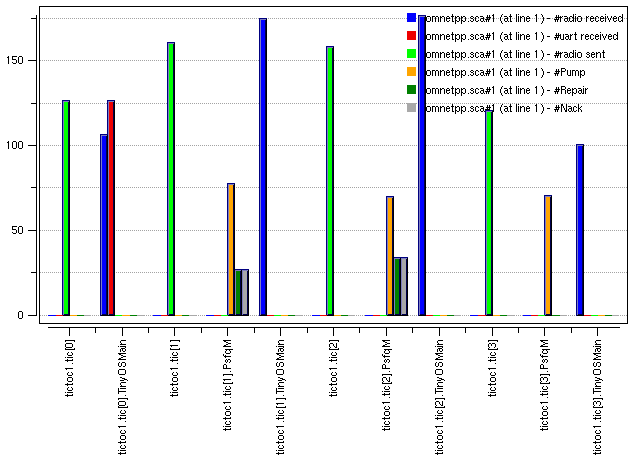Example Application: Psfq
PSFQ (Pump Slowly, Fetch Quickly) is a reliable transport protocol suitable for a new class of reliable data applications emerging in wireless sensor networks.
The documentation at
original psfq website and README file in the
distribution does not help too much, if we want to see the
behavior of the code in the simulator. Download psfq
distribution from
here . Do not overwrite psfq*.nc files in components
directory. I had to make minor changes to make it portable to
tossim and nesct for dbg messages. Copy the same behavior if
you have a recent version of psfq than the one in components
directory.
Extract psfq.tar.gz to your src directory. The contents of the
src directory should be nesct, tictoc, and psfq. Enter psfq
directory than to the tools, then type make.
[root@sinan psfq]# cd tools
[root@sinan tools]# make
gcc -g -Wall -o bs bs.c -lm
gcc -g -Wall -o sf-middleware sf-middleware.c -lm
Enter sensortopo directory and type make again. Wait until the
java files get compiled.
[root@sinan tools]# cd sensortopo/
[root@sinan sensortopo]# make
javac -classpath /root/projects/tinyos-1.x/apps/psfq/tools/
TopoGUI.java
Ok, now that psfq pc support tools are ready. Let's proceed to
simulation build.
| #include "gen/cTOSBase_TinyOSModule.h" #include "gen/cTOSBase_Main.h" #include "gen/cPsfq_TinyOSModule.h" #include "gen/cPsfq_Main.h" if (getIndex() == 0)
|
To start with, PSFQ example expects that all packets coming
from UART to go to TOSBase application. TOSBase application is
going to relay this message to other nodes using RF. For this
reason, we need a multiple application scenario.
Node 0 : TosBase
Rest: Psfq
Given the original source code and support tools, i have seen
that if TOSSIM is defined, then bs would compile for the
simulator. Nevertheless, this seems to be broken. I also have
the impression that Psfq is not maintained anymore. You can
omit this flag for now and use original tool.
NesCT is going to build all the classes in gen directory.
Replace "cp" with "copy" and slash (/) with backslash (\) for
windows operating system at the following instructions.
[root@sinan tictoc]# cd components/
[root@sinan components]# cp TosBase.nc ../Application.nc
[root@sinan tictoc]# ./nesct.exe Application.nc
[root@sinan tictoc]# cd components/
[root@sinan components]# cp Psfq.nc ../Application.nc
[root@sinan tictoc]# ./nesct.exe Application.nc
Type "make" to build the binary.
[root@sinan tictoc]# make
g++ -c -g -fpermissive -fPIC -DWITH_NETBUILDER -w
-DTOSNODES=1000 -DLINUX -DPLATFORM_OMNETPP -I./include
-I/root/projects/tinyos-1.x/tos/interfaces -I./include_tos
-I/opt/omnetpp-3.2/include simstart.cc
g++ tictoc1_n.o debug.o simstart.o tinyos.o tinyosmain.o
tossim.o txc1.o -g -L/opt/omnetpp-3.2/lib -lenvir -lcmdenv
-lsim_std -lnedxml -lxml2 -ldl -lstdc++ -lpthread -o tictoc
echo>.tstamp
Edit omnetpp.ini file and change wait-for-sf to true. After enabling this option, the simulation will wait 10 seconds before starting to allow sf to connect.
Start SerialForwarder by running ./bin/sf_sim . For windows,
you may need to enter the contents of the file yourself in a
console windows (cygwin). The exceptions will be lost once we
start the simulator.
[root@sinan tictoc]# ./bin/sf_sim
Listening to tossim-serial
SF enabled, 0 clients, 0 packets read, 0 packets written
getenv JNI library not found. Env.getenv will not work
(please consult installation directions in
tinyos-1.x/tools/java/net/tinyos/util/Env.INSTALL)
Platform avrmote
Opening tossim-serial source
Connecting to Tossim event port at localhost:10585
Listening for client connections on port 9001
SF enabled, 0 clients, 0 packets read, 0 packets written
java.net.ConnectException: Connection refused
To complicate things, let's use another topology file in ned
directory.
[root@sinan tictoc]# cd ned
[root@sinan ned]# cp psfq.ned ../bin/tictoc1.ned
Run tictoc. The simulation screen should like this.

This time I'll set only usr3 debug environment variable. Use
"export" keyword for linux and "set" keyword for windows to
change environment variable. You should see an output similar
to this in TK window.
Allow simulation to run for a while. Go to tools directory of
original psfq source code directory (../psfq/tools). Start
sensortopo topology monitoring application.
[root@sinan tools]# ./run-sensortopo

You may have to resize the window to make the control buttons
below to be visible.
Start the base station file inject procedure. we are going to
distribute test70 file to the nodes. Download test70 from here and put it to the same directory with
tools.
[root@sinan tools]# ./bs test70 -C -M
:c
Enter return to accept the [default]
group [7D]:
Tr [500]:
Tmin [1500]:
Tsimnak [0]:
TTL [2]: 5
report interval [5]:
source file (50 char limit) [test30]:
File ID [1]:
Unicast Mode? [no]: yes
Final Destination [6]: 3
Next Hop [1]:
Start Over as a new session? [no]: yes
Choose i for interactive mode
:i
file: 1120 bytes, 70 loglines
---------------------------------
Then p to start code distribution.
:p
00d:00h:00m:00.011s::sending message:0
FF FF 4D 7D 1D 01 00 00 FF FF 01 1E 00 00 00 02 01 02 03 04 05
06 07 08 09 0A 0B 0C 0D 0E 0F 01 00 00 A6 35
00d:00h:00m:01.860s::sending message:1
FF FF 4D 7D 1D 01 00 00 FF FF 01 1E 00 01 00 02 01 02 03 04 05
06 07 08 09 0A 0B 0C 0D 0E 0F 01 00 00 50 E0
00d:00h:00m:03.698s::sending message:2
If you notice, the events take too much of time in the TK
window, one way of speeding up the simulation is to build the
simulation for command environment. Go back to tictoc
directory. Edit your makefile and change the definition of
USER_IFLIBS from TK to CMD. Use # for making a line comment.
Kill tictoc (Control -C) and bs tool. Leave sf_sim and
sensortopo running. Then make again. Copy and run tictoc
again.
[root@sinan tictoc]# make
[root@sinan tictoc]# cp tictoc bin
[root@sinan tictoc]# cd bin
[root@sinan bin]# ./tictoc
See the incoming messages at bs screen.
FF FF 4D 7D 1D 01 00 00 FF FF 01 1E 00 02 00 02 01 02 03 04 05
06 07 08 09 0A 0B 0C 0D 0E 0F 01 00 00 6B 8E
***************** inject message received **********
00d:00h:00m:05.056s::src:4:dst:65535:fid:01:fsize:30:seq:0:ttl:01
code:01 02 03 04 05 06 07 08 09 0A 0B 0C 0D 0E 0F 01
****************************************************
***************** inject message received **********
00d:00h:00m:05.132s::src:1:dst:65535:fid:01:fsize:30:seq:0:ttl:01
code:01 02 03 04 05 06 07 08 09 0A 0B 0C 0D 0E 0F 01
****************************************************
00d:00h:00m:05.820s::sending message:3
FF FF 4D 7D 1D 01 00 00 FF FF 01 1E 00 03 00 02 01 02 03 04 05
06 07 08 09 0A 0B 0C 0D 0E 0F 01 00 00 9D 5B
00d:00h:00m:07.667s::sending message:4:report requested
FF FF 4D 7D 1D 01 00 00 FF FF 01 1E 00 04 00 82 01 02 03 04 05
06 07 08 09 0A 0B 0C 0D 0E 0F 01 00 00 D4 C0
00d:00h:00m:09.563s::sending message:5
FF FF 4D 7D 1D 01 00 00 FF FF 01 1E 00 05 00 02 01 02 03 04 05
06 07 08 09 0A 0B 0C 0D 0E 0F 01 00 00 EB 87
00d:00h:00m:11.411s::sending message:6
FF FF 4D 7D 1D 01 00 00 FF FF 01 1E 00 06 00 02 01 02 03 04 05
06 07 08 09 0A 0B 0C 0D 0E 0F 01 00 00 D0 E9
00d:00h:00m:13.270s::sending message:7
FF FF 4D 7D 1D 01 00 00 FF FF 01 1E 00 07 00 02 01 02 03 04 05
06 07 08 09 0A 0B 0C 0D 0E 0F 01 00 00 26 3C
00d:00h:00m:15.153s::sending message:8
FF FF 4D 7D 1D 01 00 00 FF FF 01 1E 00 08 00 02 01 02 03 04 05
06 07 08 09 0A 0B 0C 0D 0E 0F 01 00 00 D0 FA
Disable express mode in omnetpp.ini file if you want to see
the debug messages in console window. See the logger directory
and file contents about how the contents of them change.
A scalar file named omnetpp.sca is used to record statistics
about the simulation. Run scalars omnetpp.sca to graph the
following output.
